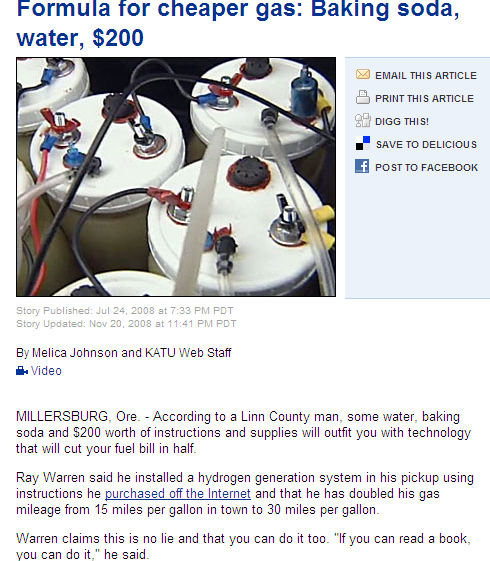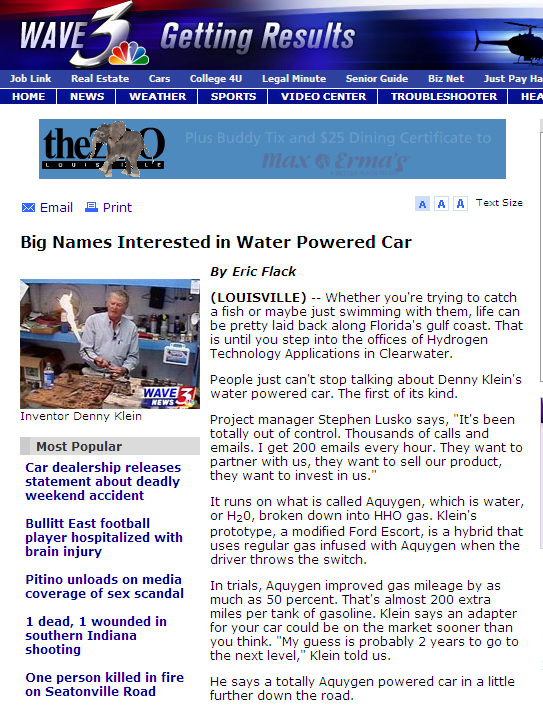- Home
- Deceptions
- Solar
- Thermal Audit
- Ventilation
- Sensors
- Governance
- Environment
- Reference
- Contact
- News
HHO, Brown's Gas and Water4Gas is a scam
These scams are based on the idea that you can disassociate hydrogen and oxygen from water using electricity. This is legitimate and the basis of many school science projects. The result is hydrogen gas and oxygen gas that can be burned together as a fuel. Other names: "Run auto with water", "Simple Water Fuel", Gas4Free, water4CAR, "Water Tech Car", "Water Car Pro", Aquygen, Hydrocharger, "Hydro*Star" and probably hundreds more.
These systems claim to achieve large increases in fuel economy, but it is predicated on a fallacy. The delusion is based on the idea that the electrical power used to make the hydrogen and oxygen is somehow "free" or "excess". This is not true. When you increase the electrical load on a car, the alternator's voltage regulator increases current in the alternator's excitation coil and this in turn makes it harder to turn. The engine then has to provide extra work to spin the alternator - and this extra work comes from the gasoline fuel being burnt.
This idea is similar to placing a wind generator on the back of a pickup truck and expecting it to power the truck, i.e. truck powers wind generator which powers truck. It doesn't work because the wind generator generates drag which slows down the vehicle, and this drag requires more fuel (energy) to keep the truck moving; the energy lost to drag is greater than the energy generated by the turbine. Energy is conserved -- the difference between wind generator output and drag on the vehicle is equal to the frictional and heat losses.
In systems like this, the prime source of energy is the gasoline being burnt. Auxiliary systems, like the vehicles electrical system are driven off the main engine. Each conversion step is less than 100% efficient because there are losses due to friction and heat. So, gasoline -> engine power -> alternator (electricity) -> water to hydrogen/oxygen gas -> additional engine fuel, is just plain wasteful. Energy is lost as heat in every step.
More subtle arguments involve the ideas that introducing hydrogen and oxygen gas into the engine air intake somehow result in better combustion. This too is silly. Gasoline in a modern engine is burned into water vapor and carbon dioxide -- there is very little unburnt hydrocarbon (gasoline or carbon monoxide) coming out the exhaust. For all practical purposes, it is all burnt in a modern engine with electronic controls and sensors. If I ever find a government study that finds an improvement of any kind in a typical automobile engine, I will post it here.
The state of Texas apparently sued Water4Gas and the court filing is archived here. Since then, water4gas has posted this material on their web sites as required by law and turned it into a conspiracy / persecution story. This is yet another case where I wonder if the inventors are delusional or just scam artists.
With any fuel saving device, especially ones that would defy common sense and the laws of thermodynamics, you need to perform carefully controlled experiments to evaluate them. I would expect a small DECREASE in fuel economy. Since no two road trips are the same because of wind, traffic conditions and how aggressively you accelerate and brake, you can expect variations of several percent in distance traveled from tank to tank of fuel. The equipment and instrumentation to test the energy output of an engine is beyond the ability of almost all consumers -- and there are doubtlessly many people who want to believe, and do see a change in distance traveled per tank of fuel. Unfortunately they incorrectly attribute the change to the device and write testimonials. See our analysis of this fuel catalyst which contains an honest testimonial that was later retracted as time passed and more fleet data was available.
I think reviewers do a disservice when they point out that the effect would be small because very little hydrogen would be produced with a small device or anything else that implies that it might work on a larger scale - and leave it at that. This gives hope for a process that is fundamentally flawed. Using engine power to drive fuel production that is then burnt is a doomed, unworkable idea.
An alternate view is this: You start with water, go through a series of processes and end up with water again, and manage to siphon off energy to move your car. This is no more silly than a car that produces more gasoline than it uses, and has to stop at gas stations to dump the extra fuel before the gas tank overflows. This is a perpetual motion machine, or "over unity" machine. Please see the Museum of Unworkable Devices hosted at Lock Haven University, Pennsylvania U.S.A., for more examples. The site is amusing too.
The press is no help either. Below are some examples of local news papers that carry uncritical stories, basically parroting marketing material, and which are then used to add legitimacy to the device.
Formula for cheaper gas: Baking soda, water, $200

The image above is pathetic. No attempt is made to question the device. Here is another:
Norfolk man pumped about savings for water-for-gas conversion

And another .. Big names interested in Water Powered Car

So much for journalists researching stories -- it wouldn't have been difficult to make a call to a nearby university's engineering department. It is most unfortunate that the public cannot rely on commercial media for anything other than a source of unfiltered corporate propaganda and are left to weed through web sites trying to find material that appears trustworthy.
Some Trivia:
The Texas complaint against water4gas claims that 3,197 Texans purchased the water4gas manual for a total of $310,109. I'd love to know what they sold world wide. It appears that scamming is a very profitable business venture.
Here is an example of a set of HHO scam plans. Here is another one called run your car on water.
To report this scam, use the FTC consumer complaint assistant.
